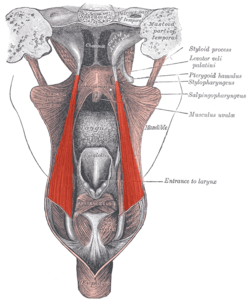The salpingopharyngeus muscle arises from the superior border of the medial cartilage of the pharyngotympanic tube (Eustachian tube), in the nasal cavity, making the posterior welt of the torus tubarius;[1] it passes downward and blends with the posterior fasciculus of the palatopharyngeus muscle.
The salpingopharyngeus is known to raise the pharynx and larynx during deglutition (swallowing) and laterally draws the pharyngeal walls up. In addition, it opens the pharyngeal orifice of the pharyngotympanic tube during swallowing. This allows for the equalization of pressure between the auditory canal and the pharynx.
The salpingopharyngeus is innervated by the vagus nerve via the pharyngeal plexus.
See also
Additional images
| Torus tubarius dissection show salpingopharyngeus muscle |
| salpingopharyngeus muscle dissection |
|
References
This article incorporates text from a public domain edition of Gray's Anatomy.
External links


